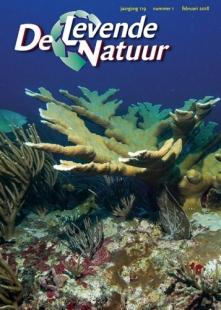De Levende Natuur nummer 1 van 2018 (English summary)
Afbeelding

Graveyards: Dutch lichen hotspots
H. van der Kolk
Graveyards are potentially highly important for lichen diversity as they can harbour a large variety of different substrates. In the Netherlands, natural rock outcrops are absent and graveyards are important in providing alternative substrates for saxicolous species. Here, the results of a lichen survey comprising 93 graveyards in the province Gelderland are reported. In total, 266 species of lichens and lichenicolous fungi were found on the graveyards, including Libertiella fennica which was recorded for the first time in the Netherlands. The highest number of species found on one graveyard was 133. 25 of the lichen species found are on the Dutch Red List species for endangered species, among which are Rhizocarpon lecanorinum, Tuckermanopsis chlorophylla and Vezdaea acicularis. Some lichen species, e.g. Placynthium nigrum, are in the Netherlands highly dependent on graveyards. It is well known that the number of species differs highly between graveyards. Graveyards with a variety of old gravestones, as well as exposed trees and nutrient poor soils suitable for lichen growth harbour the highest lichen diversity. In the Netherlands, graveyards are important for lichen diversity especially for saxicolous and terrestrial species. Therefore, it is needed to raise awareness of biodiversity on graveyards and to perform lichen surveys to map vulnerable lichen growth sites. Common measures to promote lichen growth include avoiding cleaning of gravestones and removal of fallen leaves and twigs from the soil surface between graves.
Impacts of fallow deer on butterflies in the coastal dunes of Amsterdamse Waterleidingduinen
M.F. Wallis de Vries
The population of fallow deer in the coastal dunes of Amsterdamse Waterleidingduinen (AWD) has increased to a level that raises concern for the sustainability of biodiversity objectives. For a quantitative assessment of deer impact, the present study used monitoring data over the period 1992-2016 to compare population trends of butterflies and flower abundance in the AWD area to an adjacent area with low but growing deer numbers and other dune areas without deer. In the AWD area, butterfly populations have declined more severely in the recent period with high deer densities than before. These declines are greater than in the other dune areas. Density-dependent declines are seen with increasing deer densities in local counting areas. Moreover, population declines are especially prevalent among species with nectar plants and larval host plants that are susceptible to deer grazing. Similar results were obtained for flower abundance with major declines in most flower groups in AWD in contrast to a stable trend in the adjacent area, underpinned by density-dependent declines in local counting areas. In contrast flower abundance was stable for the unpalatable Jacobaea vulgaris, which offers an insufficient resource to provide adequate nectar to the complete butterfly community throughout the season. We conclude that deer densities have increased beyond the carrying capacity for a diverse assemblage of butterflies and other flower-visiting insects. The results support the adopted strategy for active reduction of the deer population.
How to develop dry Violion grassland on former agricultural land?
R. Loeb, A. van der Bij, R. Bobbink, J. Frouz, J.J. Vogels, P. Benetkova & R. van Diggelen
Dry Violion caninae grasslands (Galio hercynici-Festucetum ovinae) are endangered in the Netherlands due to continuing soil acidification by nitrogen deposition. As a result, many characteristic plant species of this community have become scarce. However, as a Natura 2000 priority habitat (H6230), quality improvement as well as expansion of its area are necessary. Expansion of this habitat is sought outside nature reserves, on former agricultural land. Constraints for the restoration of dry Violion grasslands on former agricultural lands are the high nutrient concentrations, the absence of typical plants and animal species, and a strongly changed soil biota community. To overcome these constraints, we conducted a five-year experiment on sites with recent top soil removal, in which we added fresh hay, seeds and inoculated soil by means of crumbs, sods or slurry. It appeared that dry Violion grasslands did not develop on former agricultural land without additional measures, because of the lack of target species in the surroundings. Even if species are present, dispersal still appears to be problematic. With addition of fresh hay a 'matrix' of common characteristic Violion species can be developed. The addition of seeds of specific species next to the fresh hay addition is important for certain rare species. Because many characteristic species of dry Violion grasslands have become rare in the Netherlands and will often be absent in the donor sites of the hay, transfer with seeds is the only way they will also profit by the increase in area of the habitat. The effects of soil inoculation were smaller than in some other studies. This could be caused by the dry circumstances and the lack of organic material at the acceptor sites, in which the added biota was not able to survive. Our study demonstrated however that it is possible to stimulate the development of dry Violion grasslands on former agricultural land after top-soil removal by addition of fresh hay of a good donor site solely. Because of the low availability of soil material from well-developed dry Violion grasslands and its restricted effects, soil inoculation is not recommended as an additional restoration measure for the development of dry Violion grassland on former agricultural land.
Assessment of natural quality in the ecological network
M.E. Sanders, P. Schippers & H.A.M. Meeuwsen
Have nature management and policy been successful in maintaining species diversity and is nature quality improved? To answer these questions, nature managers and provinces proposed an uniform method to assess nature quality. These assessments are needed to support communication between the nature managers and the provinces about potential nature quality, ambitions and measures to reach this quality. Here, we show that the nature quality assessment method is strongly determined by the size and location of the assessment areas. We propose a grid based method that makes the quality assessment independent of the size of the assessment area.

